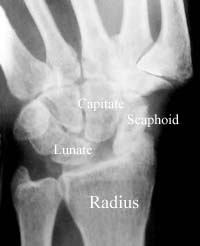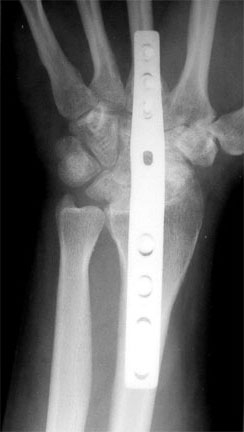Wrist Fusion
What is it?
A wrist fusion is a surgical procedure that removes the wrist joint and causes the major forearm bone (the radius) to grow into the little bones of the wrist. While this seems like a radical and crazy idea, it actually have been done for decades with great results. Patients who previously had so much pain in their wrists that they could not use their hand, find that they can lift 50 pounds without any pain and are much more functional than before surgery. Your first impression is probably that if you had your wrist fused, you could not use your hand at all. In fact, the opposite is the case. If you have a lot of wrist pain, you cannot move your wrist or use your hand. If your wrist is fused and does not hurt, you can use your hand much more.
To help you better understand what a wrist fusion can do for you, read what one patient of mine wrote about her wrist fusion: Patient Statment, Wrist Fusion
 |
 |
| This is a normal wrist | This is a wrist with a ligament rupture, and now the lunate and the scaphoid bones are too far apart. This can cause a lot of pain and wrist arthritis (note how all the cartilage is gone from between the radius and the scaphoid). |
When should a wrist be fused?

This is what a wrist fusion looks like on xray.
(not the same patient as either xray above).
A wrist should be fused when a patient has a painful wrist that cannot be treated with a smaller surgery. Examples are arthritis of the wrist bones that is so extensive that a lesser surgery will not fix it, fractures that have gone into the joints and healed badly, and ligament injuries that cannot be fixed and have led to destructive arthritis.
What can I expect?
Most patients can expect to have about an 80% to 90% chance of getting rid of 80% to 90% of their wrist pain. Almost all patients find that they can use their hand much more than they could before surgery. Heavy lifting may hurt, but simple activities like eating, getting dressed, and doing light activities generally do not hurt. No patient should need more medication than an occasional Tylenol or Motrin. Patient who want to return to work can usually return to work. Most patients can do heavy lifting or other forceful work, but some cannot. It may not be a good idea for these patients to return to activities such as roofing, which require heavy lifting in a dangerous environment. It typically takes two to four months, and occasionally six months, after surgery to get back to work. Patients of mine have returned to work as a carpenter, a muffler installer, a car mechanic, and an assembly line worker.
What are the complications?
The risk of complications is probably 20%, with most of the complications being minor, such as scar tenderness for a while. Serious complications are probably less than 10%, and include nonunion (the bones did not heal), fracture of the hand (third metacarpal) at the end of the plate due to trauma, or need for plate removal. The complications are almost always able to be fixed and do not prevent the patient from eventually returning to work.
